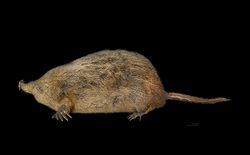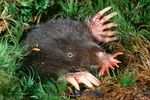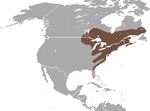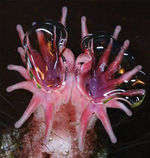Star-nosed mole
| Star-nosed mole |
|---|
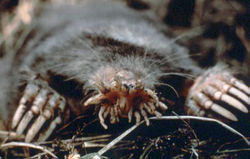
|
| Scientific Classification |
|
| Binomial Name |
|
Condylura cristata |
| Image Description |
Body Design
The star nosed mole can grow to be between fifteen to twenty centimeters in length and weigh an average of fifty-five grams. The star nosed mole is covered in black-brown water repellent fur and has four large legs covered in scales. Its eyes are underdeveloped making them nearly blind. One of the most unique features of these mammals is their nose, it has eleven pairs of fleshy pink tentacles at the end of it making it look like a star. The nose is their primary sensory organ since they are almost completely blind. The tentacles covering the edges of the nose contain twenty-five thousand highly sensitive touch receptors making it six times more sensitive than a human hand. The star nosed mole uses its tentacles to help them hunt, they identify consumable prey around them by touching it with their tentacles. [1]
Life Cycle
The breeding season for the star-nosed mole starts in mid-March and continues up through April. Each litter has between two to seven babies. They reproduce once a year but the females can reproduce a second time if their first litter was unsuccessful. They are born with closed eyes, ears and folded tentacles after two weeks these organs finally become functional. Just thirty days after their birth they become independent but it takes ten months for them to fully mature. while the exact lifespan of the star-nosed mole is unknown they live about three to four years in the wild. [2] Each new born mole is about one to two inches in length and weighs 0.05 ounces. http://www.esf.edu/aec/adks/mammals/starnosed_mole.htm
Ecology
The star-nosed mole lives mainly in the northeastern United States and southeastern Canada. The star-nosed mole is almost never far from a body of water. They prefer wet soil in swamps, meadows, flood plains, and other openings near water. They are great swimmers and divers, the star-nosed mole is also very active underwater during the winter since its more dependent on the water when the ground is frozen. In certain areas the star-nosed mole may eat mainly aquatic invertebrates. earthworms are also a big part of their diet. The star-nosed mole is active all year and while it is more active at night they are also active during the day.http://www.iucnredlist.org/details/41458/0
Use In Engineering
Video
Star nosed mole hunting explained
References
- ↑ Unknown Author Star Nosed Mole Animal Spot. Web. accessed February 9, 2016.
- ↑ Unknown Author Star Nosed Mole Animal Spot. Web. accessed February 9, 2016.
